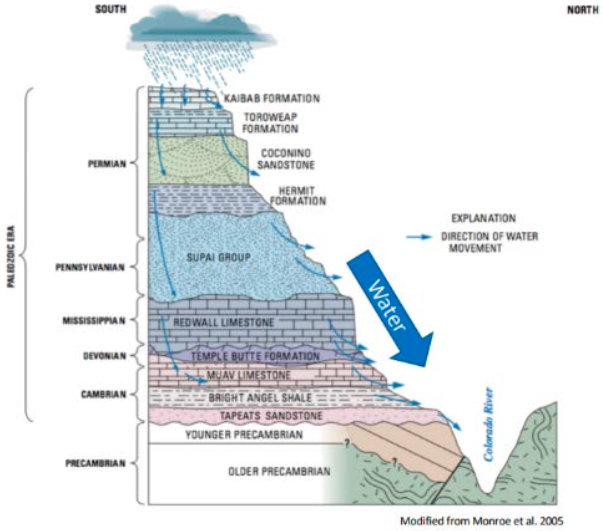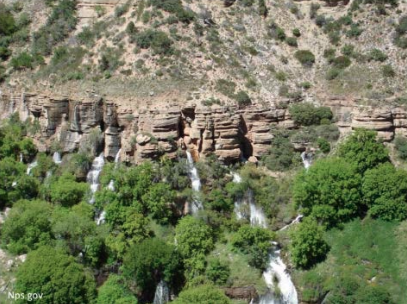The Colorado River provides water to tens of millions of people throughout the United States and Mexico, where it is used to irrigate 4 million acres of cropland and generate more than 10 billion kilowatt-hours of hydropower annually. Impoundments and surface diversions along the mainstem catch and carry its waters to users with rights to the overallocated resource. While surface inputs from rain and snow events are vital to maintaining the river’s deliveries, more than half of its flow originates underground. Amy Yoder, a hydrologist at UC Davis, explained the hydrology of groundwater in Grand Canyon National Park, its scarcity, and potential management strategies.
Hydrologic Setting
The Grand Canyon is a unique hydrologic system in that its groundwater is located above the level of its surface water. Rain that falls along the rim of the canyon seeps into the ground and down through the permeable regions of the high canyon walls. Water then gets trapped in aquifers, or underground bodies of porous rock, before being forced out of cracks at the ground’s surface in the form of springs.
Springs can come in a variety of types; 10 out of the 12 types of springs can be found in the Grand Canyon, each of them providing a reliable source of water year- round and supporting an ecosystem that is significantly more diverse than surrounding areas. In fact, springs provide habitat for 36% of the Grand Canyon’s plant and animal species, while only comprising 0.01% of the land area.

Roaring Springs: Drinking Water Source for Grand Canyon National Park
Spring-fed tributaries are particularly important to an arid region such as the Grand Canyon. During the low flow season, where snowmelt-fed streams are warm and almost dry, spring systems remain at a more stable temperature and flow as they emerge from the ground. Roaring springs is an example of one of these systems that is relied upon for its consistency.

Originating in a cave aquifer on the North Rim of the canyon, Roaring Springs spills from the canyon wall, forming Bright Angel Creek below. The water from this spring provides 100% of the drinking water to Grand Canyon National Park through a 12.5-mile-long Transcanyon Pipeline (TCP). Using gravity, water from Roaring Springs is transported to Indian Creek 3,800 feet below, where it is then pumped 7,000 feet up to the South Rim. It is also directly pumped from the spring 3,000 feet up to the North Rim. The 21 cubic feet per second of flow delivered through the pipeline is a necessity for operating Grand Canyon National Park.
Groundwater Scarcity and Management
Given the importance of groundwater to the Grand Canyon, monitoring its levels and identifying scarcity is essential. Growth of surrounding communities like Flagstaff, Arizona, which relies on groundwater for 40% of its water supply, have resulted in steep storage reductions of aquifer systems. Additionally, decreasing discharge has been documented in springs throughout the park, a trend that is harmful not only for humans, but also the ecosystems that rely on the freshwater source.
Furthermore, the Grand Canyon National Park’s water demand is expected to double by 2050, which will place even more stress on groundwater systems. Of particular note is the TCP, which has proven to be unreliable and prone to leaks since its construction in 1965. Increasing groundwater scarcity makes it important to ensure that the water makes it from Roaring Springs to the South Rim with minimal loss.

In order to address these issues, the US Bureau of
Reclamation conducted a water appraisal study in 2002
to plan for future water needs. The study outlined potential strategies that could be implemented to reduce losses during transfer. One is to drill a well directly into the aquifer that supplies Roaring Springs, which would be used to supply the North Rim with water, while still using the TCP to supply the South Rim. Another is to replace the aluminum pipeline with steel, thereby increasing the durability and reducing leaks. This is an expensive and logistically difficult strategy, however. A third is to construct a pumping plant on Bright Angel Creek, reducing the distance water would travel in the TCP, but also requiring a water treatment plant to ensure its safety.
Along with infrastructure changes, the state of Arizona has shown that management practices can be effective in reducing over-extraction of aquifers. A groundwater monitoring and management strategy implemented in 1980 has been successful and led some to advocate for a federal oversight program. In any case, ensuring a lasting groundwater supply in the Grand Canyon is imperative to providing users a hospitable place to visit.
